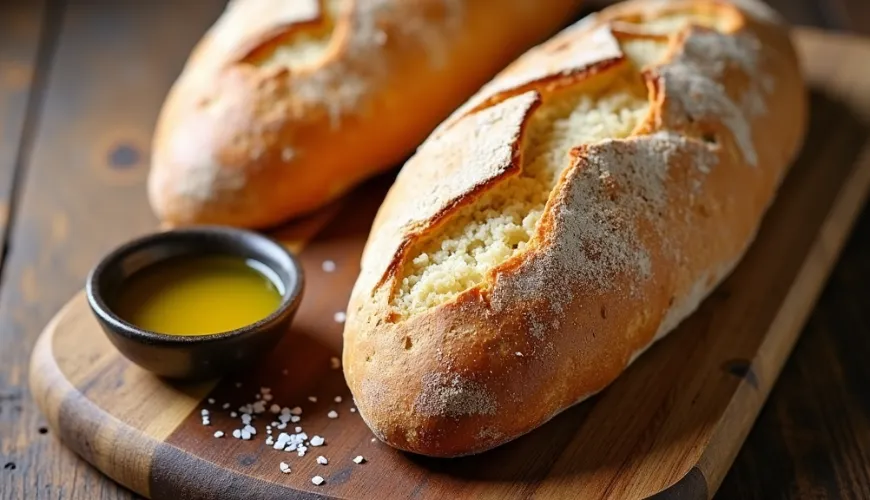
The Story of Italian Ciabatta and How to Easily Make It at Home

Homemade Ciabatta and Its Story
It is said that a home smells like what’s baking in it. And if that happens to be ciabatta – a crispy Italian bread with irregular crumb and a mildly sour aroma – there’s no doubt where the wind blows from. Ciabatta is a symbol of Italian baking artistry, which combines the simplicity of ingredients with an emphasis on technique. You might be surprised to learn that this bread isn't as old as it might seem. Yet, within just a few decades, it has become a favorite in kitchens worldwide, including those in the Czech Republic.
How Did Italian Ciabatta Originate?
Although one might think that it is a recipe passed down through Italian families for generations, the opposite is true. Ciabatta, which translates to "slipper," was created only in 1982. In a small bakery in the Veneto region, baker Arnaldo Cavallari was concerned that the Italian market would be flooded with baguettes from France. He wanted to create his own simpler, yet equally appealing alternative. The result was ciabatta – a bread with a rustic appearance, soft crumb, and crispy crust, which quickly conquered not only Italian shelves but also international stores.
It is fascinating that even though ciabatta is a relatively young invention, its style resembles traditional artisan bread. It employs long fermentation and high dough hydration, which gives it its characteristic structure – cavities in the crumb and a slightly chewy texture.
Why Bake Ciabatta at Home?
You can find it on supermarket shelves almost everywhere today, but homemade ciabatta has its unmistakable charm. The recipe for homemade ciabatta is surprisingly simple, though it requires a bit of patience. And the result? Dough that takes on a life of its own during rising, and an aroma that reminds you of a small bakery hidden in the stone alleys of Tuscany. Above all, you know what you’re eating – no additives, no preservatives, just water, flour, yeast, salt, and a drop of olive oil.
Moreover, baked ciabatta pairs wonderfully with many dishes. From the simple combination with olive oil and sea salt, to sandwiches filled with mozzarella and tomatoes, to a side for hearty soups. It is a versatile bread that adds flair to any meal.
Simple Recipe for Homemade Ciabatta
Although there are various versions, the basic recipe remains similar. The following version is inspired by one of the episodes of the show “With an Italian in the Kitchen,” where the popular chef Emanuele Ridi ventured into baking alongside a Czech cook. He showed that even simple ciabatta can be the result of the joy of cooking – all it takes is a little love for Italian gastronomy.
Ingredients:
- 500 g all-purpose flour (preferably type 00)
- 400 ml lukewarm water
- 7 g dry yeast (or 15 g fresh)
- 1.5 teaspoons salt
- 1 tablespoon olive oil
- optionally: a pinch of sugar to speed up fermentation
Instructions:
- In a bowl, mix the flour, yeast (and optionally sugar). Add water and start mixing. The dough will be very thin, almost liquid – that's okay.
- Add salt and olive oil. Continue mixing until the dough starts to pull away from the sides of the bowl. You can use a stand mixer, but even a spoon or hands will do the job.
- Cover the dough with plastic wrap or a cloth and let it rise in a warm place for 2–3 hours, until it doubles in size.
- Transfer the risen dough to a well-floured work surface. The dough is sticky – it’s ideal to use a scraper. Divide it into two rectangles and let it rest for 20 minutes.
- Preheat the oven to 230°C. It's ideal to bake ciabatta on a baking stone or in a cast-iron pot, but a classic baking tray will suffice. Place the ciabatta into the oven and bake for 20–25 minutes until golden.
What makes this bread exceptional is its simplicity. Italian ciabatta doesn’t need sophistication, its strength lies in honesty. And when you pull it from the oven, you’ll hear that unmistakable sound of the crispy crust meeting the knife.
In practice, baking ciabatta at home can be a surprisingly personal experience. For instance, Mrs. Lenka from Brno, who learned to bake during the pandemic, recalls: “At first, the dough reminded me of glue, but once I got it, I bake ciabatta every weekend. I add a sprig of rosemary or olives – depending on my mood.”
How to Store Ciabatta and What to Do With It?
Freshly baked ciabatta tastes best within the first 24 hours. But if you don’t eat it immediately, wrap it in a cloth napkin or bread bag and store it at room temperature. Avoid plastic bags – the bread will sweat and lose its crispness. The next day, it’s ideal to briefly reheat it in the oven or on the grill.
Whether you’re planning a brunch, picnic, or a simple dinner, ciabatta always fits in. You can make crostini, panini, or just drizzle it with olive oil and sprinkle with dried oregano. Combined with a tomato salad and a glass of white wine, it offers a taste journey to the heart of Italy.
If you like experimenting, try adding sun-dried tomatoes, black olives, or herbs to the dough. The variations are almost endless – and that’s the magic of ciabatta. It’s a bread that isn’t afraid to stand out.
Today, ciabatta has as strong a position in the world as the baguette or naan. It’s a bread that has become a symbol of simplicity, but also creativity. And above all – it’s proof that sometimes the best things come from ordinary ingredients when we give them time and care.
So, what do you say, are you up for baking your own ciabatta? It may initially be as pliable as spilled cream, but once you taste the first piece, you’ll understand why this bread is loved by people from Venice to Brno. And maybe, when you close your eyes and bite into the warm crumb scented with olive oil, you'll briefly really feel the sea.

